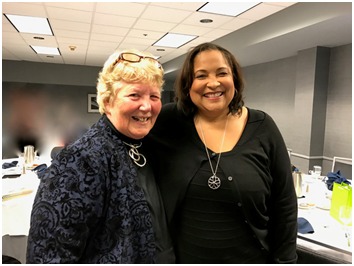Making Room for One More, A Simple Act of Micro-Inclusion
Organizations have learned that workforce diversity affords a competitive advantage when selling to diverse consumers. Businesses recognize that diversity in the workforce leads to more highly engaged teams and provides a better arena for innovation to occur. Companies also know that diversity alone isn’t the answer and that lasting workforce diversity doesn’t happen without creating environments where multiple cultures, ethnicities, genders, and abilities are welcomed, included, and respected.
However, in many organizations, there remains a void between understanding inclusive behaviors and putting them into practice. Sometimes, it seems that valuing co-workers and mutual respect are an odd concept, despite most of us having been taught as children to treat others as we want to be treated. Why wouldn’t that basic admonition from our parents and grandparents hold true in business contexts?
Harvard Business Review writers Laura Sherbin and Ripa Rashid reason that “part of the problem is that ‘diversity’ and ‘inclusion’ are so often lumped together that they’re assumed to be the same thing. But that’s just not the case. In the context of the workplace, diversity equals representation. Without inclusion, however, the crucial connections that attract diverse talent, encourage their participation, foster innovation, and lead to business growth won’t happen.”
Recently, I had an experience with a local business owner that simply and beautifully articulated the power of inclusion and imparted lessons about transferring this power into the marketplace. My encounter with Mary Helen Conroy, retirement expert, author, podcaster, life coach, and motivational speaker, gave me three life lessons that you can put into practice today to build more diverse and inclusive work cultures.
Most of us have had the experience of being excluded. Whether from a sports team as a child, the popular kids lunch table in high school, the dominant culture in one of several social situations, or the high potentials at work, whatever the reason or circumstance, knowingly being excluded is far from a good time. Sometimes it is obvious and intentional. Other time, it is subtle or unintentional. No matter how it happens it leaves a bad feeling.
For this reason many of us get more than a little unnerved at the thought of attending events alone. I was feeling a bit that way as I was preparing to attend a recent professional association event. I knew the president of the organization and was excited about the speaker and subject matter. However, a set of circumstances arose that prevented me from arriving early. This meant I’d arrive during the introductory networking time and would have to wade through the crowd to find a seat. My experience upon my arrival, however, was different than expected and an example of what I have coined “micro-inclusion.”
As I have defined it, a micro-inclusion is any small behavior, gesture, or conversation that invites, takes in, or embraces a person or group of people into another group as part of the whole. This is what I experienced at the professional association event.
I’d been invited to attend this meeting by the organization’s president. After receiving an email about the current month’s speaker, I decided to a register as a first-time guest and attend. Where I live and work, I am often one of few people of color at almost any event I attend and one of an even smaller number of women of color. This day was no exception.
 Because of the type of organization, as I expected, I was warmly greeted and instructed about the check-in process, name tags, coat rack, etc. As I scanned the room, I noted that most tables near the front were full. So, I walked around to the rear of the room where I saw a table with an open chair. I made eye contact with one of the women at the table and asked if the seat was open. She politely told me that a gentleman had previously been sitting there and she thought he would be returning soon. So, no, it was not. I acknowledged her reply and began to turn to see where else I might find a seat in the room. What happened next made all the difference in my afternoon.
Because of the type of organization, as I expected, I was warmly greeted and instructed about the check-in process, name tags, coat rack, etc. As I scanned the room, I noted that most tables near the front were full. So, I walked around to the rear of the room where I saw a table with an open chair. I made eye contact with one of the women at the table and asked if the seat was open. She politely told me that a gentleman had previously been sitting there and she thought he would be returning soon. So, no, it was not. I acknowledged her reply and began to turn to see where else I might find a seat in the room. What happened next made all the difference in my afternoon.
Before I could turn fully away to find another seat, Mary Helen jumped up and said, “We can make room for you here! Pull up a chair.” She smiled, got up, and immediately came to my aid. Mary Helen scooped up a place setting from an empty table, sat it down on the table right where I was standing, looked me in the eye, held out her hand, and welcomingly introduced herself. This was the beginning of a delightful afternoon learning from a fantastic presenter, meeting six new women, and learning about their careers, aspirations, and experiences. I have no doubt that I’ll have future meetings with at least three of those women, including May Helen. In one afternoon I learned ideas from her and the other women at that table that I am already beginning to put into practice. The most important thing I experienced, though, was the power of micro-inclusion.
More times than I care to recall, I have been on the receiving end of micro-aggression. I have also been disregarded, ignored, overlooked, or excluded in professional settings, as I know many others have, too. This is one of the reasons many of us are apprehensive about networking or going to professional development events, especially attending alone. Most of us don’t want to be the new person, risk an awkward or unpleasant interaction, or we simply haven’t mastered the skill of networking. However, there are the rare occasions when someone makes it pleasant for you. She extends herself and demonstrates how micro-inclusive behaviors, the little extensions of “do-unto-others-ness,” can enhance business (or any) relationships, creativity, and productivity.
This is what happened for me that day. Mary Helen’s behavior was refreshing. Not only did she welcome and engage me, she was authentic in doing so. It seemed that Mary Helen is “just that way” all the time to everyone. Simply put, she was nice and she included me.
So, here are three micro-inclusive gestures I experienced from Mary Helen that I recommend we all put into action:
- Be willing to make room for one more, especially someone different. Because Mary Helen said there was room for one more and I gladly sat at the table, I could share my background, ask questions, and add insights to conversations that would have been missed had I sat somewhere else. I learned great information and met a wonderful group of women, at least half of whom I know I will connect with soon for networking and support.
- Be solutions and action oriented. Mary Helen told me to pull up a chair and got right up from her seat to grab a place setting for me. She assessed the situation, saw my problem, and met my need. She was a perfect example of how being inclusive doesn’t a take a whole lot of effort. It simply takes looking for an opportunity to treat someone the way you would want to be treated. It’s a small or “micro” gesture that makes a huge impact.
- Get connected. Mary Helen came prepared with business cards, gave me hers, and asked for mine. Before the evening was out, she’d connected with me on LinkedIn and sent me a lovely message offering well wishes for a great year and her support if ever I needed it. And, I am sure I will.



Leave a Reply
Want to join the discussion?Feel free to contribute!